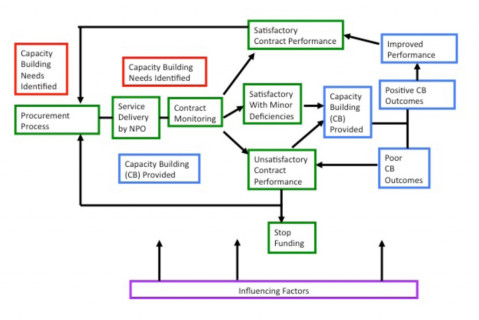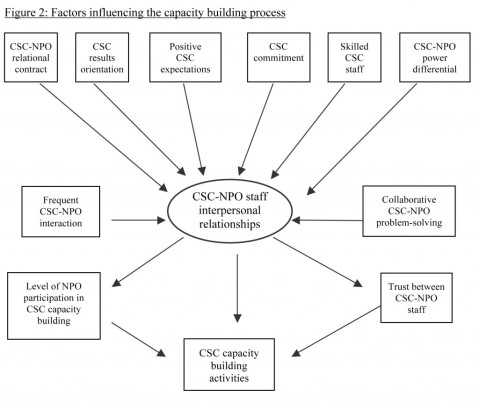Widgetized Section
Go to Admin » Appearance » Widgets » and move Gabfire Widget: Social into that MastheadOverlay zone
A Local Government Model for Building Nonprofit Capacity
Catherine Raymond, Sue Gallagher, K. Lori Hanson
Local government agencies have long contracted with nonprofit organizations (NPOs) to provide publicly funded human services. In many communities, the local NPO “market” is limited–comprised largely of community-based organizations that may have difficulty meeting increasingly rigorous government accountability and performance standards. To ensure responsible use of public funds and address gaps between NPO capacities and government standards, some local government agencies provide assistance to their contracted NPO service providers in an effort to improve contract performance. This type of assistance is also known as capacity building.
Unfortunately, there is a dearth of guidance for public managers on what constitutes successful capacity building in a contracting context, what factors influence the capacity building process, and the resources required. This article provides such guidance by presenting a model for integrating capacity building into a typical local government contracting process and highlighting the findings of a study conducted at two county-level public funding agencies located in large, diverse South Florida counties (Raymond, 2010).
The Children’s Services Council of Broward County and The Children’s Trust (in Miami-Dade County) are both Children’s Services Councils (CSC)–independent units of local government established by voter referendum to fund programs and services for children and families. These CSCs were established in 2000 and 2002, respectively. Both are funded through property taxes with annual budgets (FY2012) of $63 and $100 million and 140 and 260 active service contracts, respectively. CSCs typically contract with agencies through a competitive request for proposal (RFP) process providing multi-year funding with annual renewals based upon successfully achieving annual contract performance measures. The vast majority of contracted service providers are 501(c)(3) nonprofit organizations but also include a small number of for-profit businesses and other government agencies.
CSC Capacity Building Model
Typically, capacity building is seen as a supplemental activity to contracting processes. However, the capacity building model developed by the CSCs (see Figure 1) is fully integrated into contracting processes–facilitating the implementation and impact of capacity building as well as increasing cost-effectiveness. The green boxes in Figure 1 indicate a typical contracting process. NPO capacity building needs (red boxes) are identified through contract monitoring processes including review of NPO performance data, staff observation, and discussions with NPO staff. Needs are occasionally also identified during the procurement process. Capacity building activities (blue boxes) are available to all contracted NPOs throughout contract implementation. Special emphasis is given to providing assistance to NPOs identified as having less than satisfactory contract performance with the aim of increasing performance to satisfactory levels. Throughout the process there are a number of factors that influence the success of capacity building efforts (purple box).
The CSCs’ experiences indicate the greatest areas of NPO capacity building need are: documentation and reporting, financial management, program monitoring and evaluation, utilization of evidence-based practices and, in some cases, participant recruitment and retention.
To address these needs the CSCs employ a wide range of capacity building activities–many of them provided by CSC staff. To a large degree, the CSCs integrate capacity building into typical contracting processes (e.g., contract monitoring)–taking advantage of “teachable moments” to provide individualized coaching to NPO staff. While group training plays an important role in CSC capacity building, the CSCs have found that activities involving customized, individualized support appear to be most effective. The CSCs’ primary capacity building activities include:
- Individualized technical assistance provided by CSC staff as well as organizations contracted to provide assistance
- Annual onsite contract programmatic and fiscal/administrative monitoring as well as monthly communication on contract progress between CSC and NPO staff
- Group training on contract performance related topics (online and in-person)
- Assistance with data management and analysis including a web-based system for contract performance reporting as well as training and assistance using program data for continuous quality improvement
- Integration of the Results-based Accountability™ framework (Friedman, 2005) into capacity building
Factors Influencing the Capacity Building Process
The study identified a number of factors that impact the implementation and success of CSC capacity building (see Figure 2). A high quality relationship between CSC and NPO staff (center of figure) is at the core of successful capacity building. Eight characteristics appear to influence the quality of this relationship. The six in the top row are characteristics of the CSCs that “set the tone” for the CSC-NPO relationship:
- CSC-NPO relational contract: The CSCs utilize a partnership-oriented contracting approach characterized by frequent and informal communication, collaborative implementation, joint problem solving, and monitoring for continuous quality improvement.
- CSC results orientation: The CSCs focus intensely on results and invest significant resources in systems for collaboratively collecting, analyzing, and utilizing program performance data.
- Positive CSC expectations: The CSCs expect success to result from NPO efforts; any problems identified during monitoring are used to direct capacity building efforts rather than in a punitive sense (with appropriate responsibility to end ineffective NPO services if positive changes do not result from capacity building).
- CSC commitment: The CSCs are committed to supporting their NPO partners, recognizing that the CSC doesn’t succeed if the NPOs don’t succeed.
- Skilled CSC staff: Staff have expertise in relevant service areas and prior NPO experience.
- CSC-NPO power differential: While the CSCs have the “power of the purse”, staff aim to use it as a motivational, rather than a threatening, force.
Two additional characteristics (left and right sides of figure) are important in developing and maintaining effective relationships. CSC staff, particularly contract managers, develop strong working relationships with their contracted NPO partners through frequent contact and collaboratively working to solve contract problems.
As indicated in Figure 2 (bottom), this relationship, when of high quality, results in increased levels of trust between CSC and NPO staff creating an environment more conducive to capacity building. A high quality relationship also appears to increase the level of NPO participation in CSC capacity building, increasing the likelihood of contract improvements.
Active NPO participation is critical to successful capacity building. In addition to a positive, high quality CSC-NPO relationship, study results point to other factors that appear to increase NPO participation in capacity building:
- Active interest in capacity building from the NPO Executive Director/CEO
- An NPO organizational culture that embraces organizational learning and ongoing quality improvement
- NPO perception that CSC capacity building is a valuable resource (i.e., relevance of the capacity building topic, scarcity of other resources, use of highly qualified capacity builders)
- Past successful NPO grant or contract management experience
- Presence of basic NPO fiscal, administrative, and data systems
- Lack of NPO fiscal or organizational crises
- Capacity building provided by CSC in places, and at times, convenient for NPO staff
- Resources necessary for capacity building
Public agencies interested in capacity building should assess the extent to which the aforementioned factors are present, or can be built, in their contracting relationships. The CSCs’ experiences also point to challenges public managers may face. Some local government agencies may not have the human resources, organizational culture, or contracting processes necessary for successful capacity building. In particular, many local governments currently do not employ the relational contracting approach, nor have highly qualified contract managers (with the time to develop relationships with contractors), both of which are critical factors in successful capacity building. Additionally, since capacity building is not a traditional local government function, public managers may need to expend efforts to garner support and necessary resources for capacity building–agency leadership support is critical.
Both The Children’s Services Council of Broward County and The Children’s Trust in Miami-Dade County have demonstrated that local government agencies can successfully strengthen the contract performance of their community-based nonprofit partners resulting in improved outcomes for children and families and more effective use of public dollars.
For additional information, contact Catherine Raymond at [email protected].
Catherine Raymond is president, Raymond Consulting, Inc.
Sue Gallagher is director of research, analysis, and planning at Children’s Services Council of Broward County.
K. Lori Hanson is director of research and evaluation, The Children’s Trust, Miami-Dade County.






Anonymous
March 23, 2012 at 11:03 am
I agree with the previous poster. Please make the figures static – it makes it very difficult to read the article – most/many readers won’t know about the control bar. Also one of the figures is referred to in detail within the article but then you have to scroll to the top – and then stop the movement – to view it. Much better to just lay the figures out as separate static graphics
Anonymous
March 22, 2012 at 6:47 pm
If you run your cursor over the bottom of the graphic, a control bar pops up. If you click the second button on the left of the bar, it will pause the graphic. When you are ready to proceed, click again and it moves to the next graphic.
Anonymous
March 22, 2012 at 6:05 pm
This looks like a useful article, but I’m unable to focus on the graphic because it never stops moving. That’s frustrating to the point that it turned me off – I didn’t bother reading the entire article. If you really want to make your case, focus on the information value above all and drop the gimmick.